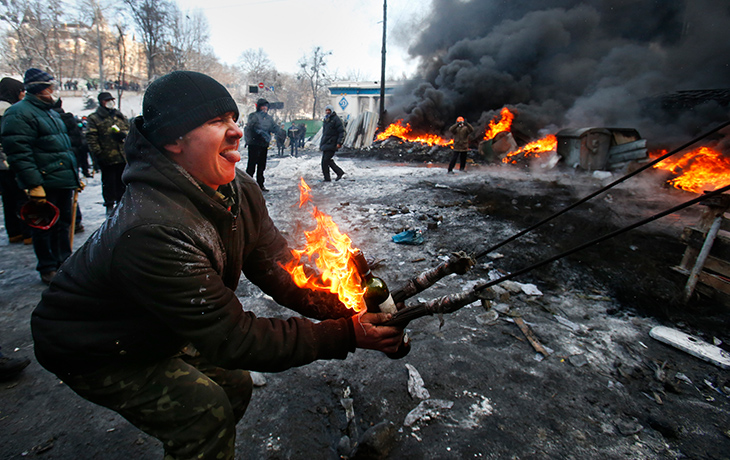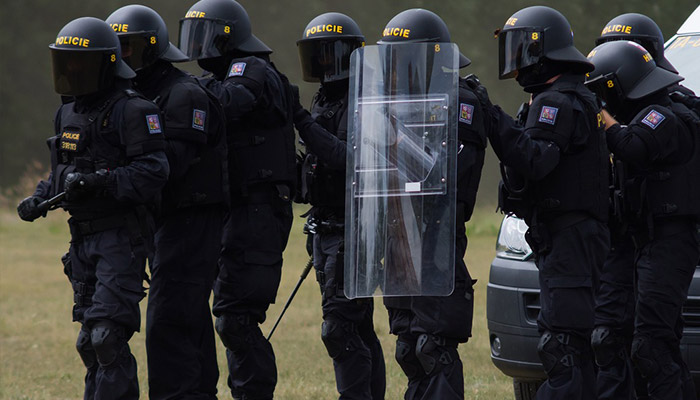Editor’s note: No one is advocating for any ‘side’ or encouraging people to ‘jump in the fun’ — nonviolence is always better than violence when you have a choice. That said, it is valid to help people understand what happens during unrest and how to protect themselves, both if they are an innocent bystander and if they choose to join. There are, after all, plenty of examples where civil disobedience was a justified measure of last resort — remember the American Revolution?
As is the case with most emergency scenarios, the way you prepare for civil unrest is mostly the same as how you prepare for anything else. Besides the protest gear listed below, follow the beginner’s emergency preparedness checklist to get your basics covered for things like food, medicine, comms, cash, and a bug out bag.
You could skip this guide entirely and those basics will be enough in most cases. You see unrest spinning out of control in your area, for example, and you either go into turtle mode to defend and shelter inside of your home, or you bug out and leave the area. That’s basic prepping.
The most important stuff to remember:
- Most tips boil down to “stay away from the unrest!” Physical distance is the best way to keep yourself safe and cool down tensions within a crowd.
- Civil unrest happens when the “social contract” or rules that we all agree on for a happy society start to break down. That means you can’t depend on normal rules being followed, including by government.
- “A person is smart, but people are dumb.” Crowds are unpredictable and things can change in an instant. Always be situationally aware.
- “Non-lethals” are now formally called “less-lethals” because they actually do kill and seriously hurt people. Don’t assume you’re safe or that they’re no big deal.
- The best way to treat things like tear gas and pepper spray is clean water and patience.
- Know your rights. Review ahead of time, and possibly print to carry with you, a copy of individual rights such as the ACLU’s Protesters’ Rights Guide or your local self-defense laws.
- “Protest kits” are worth preparing if you choose to attend a protest.
- Standard business or personal insurance usually covers some of the costs of damage from unrest, but often not all, and there’s a subjective exception when the damage is due to “terrorism.”
- Protest supplies
- Types of civil unrest
- Why civil unrest happens
- Control is the government's goal
- Non-government threats to watch for
- How to prepare for unrest ahead of time
- Tactics governments use during unrest
- Riot Control Agents
- How to treat pepper spray and tear gas
- Other Crowd Control Weapons
- Distance is the best protection
- What to do if your home/business is nearby
- What to do if you get caught in unrest
- What to do if you're in a vehicle
- How to handle direct police encounters
- How to help other people
What to bring to a protest
If it’s hot outside and you don’t want to wear full-coverage clothing, find other ways to keep a barrier over your skin. Anything is better than nothing. Nylon and other synthetic materials work well to protect against both heat and chemicals — many Hong Kongers, for example, have been wearing athletic arm and leg sleeves in the humid heat.
When it comes to protective gear on your head, you have multiple options:
- A full-face respirator (ie. a gas mask) that protects your eyes, nose, and mouth with one product.
- A half-face respirator (eg. a disposable N95) that protects your nose and mouth, combined with separate airtight safety goggles.
- If you don’t have a proper respirator, a bandana or similar is better than nothing and will prevent facial recognition, but they are largely ineffective against riot chemicals.
- A helmet or some other covering to protect the rest of your head.
Note that a growing number of places are making it illegal to cover your face, precisely because they want to see you. So be intentional about any hats, face coverings, etc.
Heat-resistant gloves are better than a normal glove because some of the crowd control weapons police use — eg. tear gas, smoke, and flash bangs — get very hot after they’re thrown into the crowd.
If you bring your phone with you, consider putting it in airplane mode so you’re less likely to be tracked. If your phone is locked with your face or fingerprint, the legal bar is lower for police to force you to unlock it compared to a passcode-type lock. (They can take your fingerprints without a warrant, but not force you to recite something from memory.)
Don’t rely on having your phone for important information. Many people keep emergency phone numbers (including their lawyer, ACLU, etc.) on paper in their pocket or shoe. Some even write them in permanent marker on their skin. Some carry enough cash to make bail.
When it comes to armor and self defense, use caution. While you have the right to defend yourself, there are valid arguments to leave this stuff at home in favor of less-lethal / less-escalating / more-defensive options that also won’t make you look like a trouble-maker.
Avoid:
- Contact lenses. We haven’t seen any official studies to support this, but there are many stories where people felt their contacts made things worse when they got hit with a RCA such as tear gas. If you have no other choice, be sure to wear sealed goggles or face masks.
- Makeup. Not only will makeup such as eyeliner get messy if you get hit with an RCA, but it might trap the chemicals, too.
- Perfumes and oil-based lotions. Same reason as sunscreen and makeup.
- Inflammatory clothing. Wave signs and shout all you want. But if you’re wearing a shirt that says “F the police” (or whatever), it will be hard to claim later that you were just a bystander.
- Anything you don’t want to be arrested with.
Be prepared. Don’t be a victim.
Want more great content and giveaways? Sign up for The Prepared’s free newsletter and get the best prepping content straight to your inbox. 1-2 emails a month, 0% spam.
Types of civil disorder
On the surface, most riots and unrest happen because of:
- Bad actors tipping a peaceful protest into a violent one
- Another disaster happening first, like an earthquake or depression, and people are reacting to the lack of help, supplies, etc.
- Disagreement over something political or religious, such as a labor dispute or economic disparity
- Government oppression
- Sports
By its very nature, civil unrest tends to be a bigger problem in denser areas like cities because it takes a crowd of people for things to boil over. When people are in closer proximity with each other, they more clearly feel injustices and negative emotions even if they aren’t the ‘victim.’ Thus, the denser an area, the easier it is for unrest to spread.
It’s a few years outdated, but this video has some footage from the “top 10 riots of the past 100 years”:
Civil unrest happens when the social contract breaks down
It’s worth understanding the psychology behind why these events happen. The more you understand unrest at its core, the better you can prepare and adapt in the unpredictable moment.
The alcohol-fueled stupidity of sports riots aside, civil unrest typically happens when people feel that the normal ways to create change or address their grievances have failed.
Normal society functions via a “social contract” where (most) everyone agrees to a certain set of rules, including giving some people (usually elected leaders) special powers over the masses. The community almost always agrees, for example, that even though we may disagree about a political issue with every cell in our body, we don’t kill each other because civil discourse is better than civil unrest.
Civil disorder is usually an act of desperation — and desperate people are dangerous people.
99.9% of people want to play by those rules, even when they’re unhappy. So things have to get pretty bad to cause people to say “screw it, the contract is fundamentally broken, time to reject the rules and level the playing field, even if it means hurting other people or putting myself in danger.”
It’s similar to why whistleblowers like Edward Snowden go public. The official channels built into the contract for fixing problems aren’t effective, so they go outside of the rules to try and force change — in Snowden’s case, following the rules would’ve meant only filing an internal complaint and/or resigning, which wouldn’t have fixed the problem.
That’s why the primary objective of government is to get things back under control
Consider sociologist and political economist Max Weber’s definition of government: The government is whomever has a local monopoly on violence.
That monopoly is usually legitimized through the social contract: “We the people agree to give you authority to kill some of us in exchange for keeping things under control.”
Threaten that monopoly or break the social contract and you threaten the very existence or legitimacy of a government. In other words, if the government doesn’t at least appear to have things under control, then the delicate balance that keeps society from falling apart could quickly go out the window.
During unrest, the visible faces of government (eg. riot police) only cares about two things, in this order:
- Protecting themselves from bodily harm
- Getting things back under control
That’s it. They don’t care about one specific business currently on fire the way they would care in normal times. They don’t care what the political message is. They don’t care if people think an arrest is unfair.
So it comes as no surprise that governments can react very strongly during times of civil unrest, even ignoring their side of the rules in the contract they agreed to and swore to uphold. It’s a primal fight-or-flight response — and they usually don’t want to flee or be overthrown — which means the government usually reacts the way a cornered animal would in order to protect their existence.
There are plenty of examples, including in the US, when the government used social unrest as an excuse to ignore civil rights or change their normal policies. A cop in a riot might not come to your aid, for example, since they have bigger worries and there aren’t enough resources to go around.
In the 2020 Black Lives Matter protests, for example, a New York Supreme Court judge suspended habeas corpus legal protections for people rounded up in mass arrests, claiming the system was too overwhelmed to handle it — ie. “the normal rules don’t apply right now.”
Non-government things to watch out for
A situation could get severe enough that it’s no longer about a group of people vs. government, and instead becomes more of a lawless “everyone for themselves” or SHTF scenario — but that’s not covered in this guide.
Even in a simple scenario where it seems like one group of people vs. the government, agent provocateurs, false flags, and plain ol’ criminals can make things much more complicated.
Whether you’re trying to avoid the unrest altogether or you’re involved but trying to keep things peaceful, it’s worth knowing these common problems because they can quickly make a scenario unpredictable and dangerous.
Since social unrest means the normal rules don’t apply, that attracts bad people who come out of the woodwork to exploit a chaotic situation. They might not care at all about the ‘cause’ and instead just want to get a free TV during looting.
Agent provocateurs might just get a kick out of stirring the pot. Or they might be part of an intentional false flag operation where one group who wouldn’t normally be a part of the unrest/cause intentionally create trouble in a way that will place the blame on the main protest/cause.
Disinformation became a powerful tool as the internet spread through society. Studies show every person reading this has likely (but unknowingly) shared disinformation at some point.

When things are bad enough to cause unrest, that means things are hot enough where all someone has to do is throw more fuel on the fire by spreading something false but inflammatory. Sometimes these are just mistakes, bad actors, or unethical media people, and sometimes it’s foreign adversaries using the unrest as a crack to pry people further apart.
More: Mysterious brick piles and gasoline bottles — staying safe and sane despite riotous rumors
Causing trouble not only distracts from the real message, but it can directly undercut that message or goal. Consider recent police brutality protests, for example — false-flag provocateurs who disagreed with the message might have attacked police while dressed up as a protestor, making it harder for the general public to be sympathetic with the message of “police should be nicer!”
Other common problems in and around social unrest are:
- Identify theft and similar scams
- Muggings and car jackings
- Rape and sexual assault
- Domestic violence
- Destruction or theft of any property that’s easily accessible from the street
How to prepare for civil disturbances ahead of time
Besides the prepping basics, there are a few things you can do to specifically prepare for civil unrest.
If there’s a specific event you’re worried about, learn the basic talking points and uniforms for each side. You might find yourself in a situation where you need to talk your way out of danger or pretend you’re part of the crowd. You might normally not care about a particular cause/view, or even strongly disagree with it, but there’s no shame in saving your life by pretending to be “one of them.”
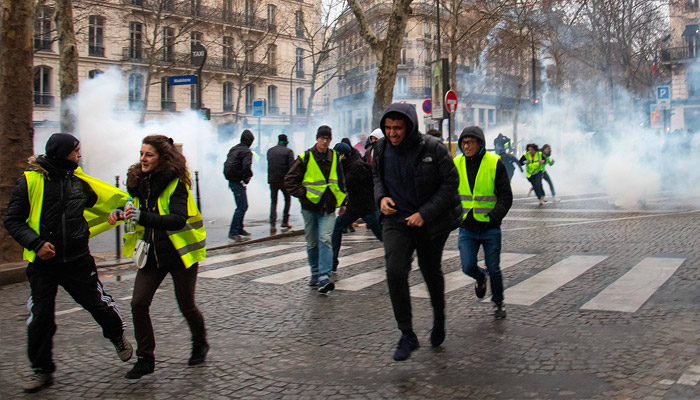
If there’s a de facto uniform, such as the white vs. black shirts in the 2019-20 Hong Kong unrest or the yellow vests of the 2018-19 French unrest, perhaps have one of each so you can blend in with whichever group you need to get past.
Know your surroundings. Many people can spend years in the same home but never see even a block away from them if it’s not in the direction they normally take. Take walks in all directions possible away from your home. It’s easy exercise and will help you know what kinds of threats, magnets, resources, and escape routes are around you.
Know your neighbors. Unrest is a time you may be relying on your neighbors for help (or helping them). Know who’s around you, and in particular, if there are people likely to cause trouble or join/fight you in your cause.
Know what the big magnets are in your area. Are there particular parks that people tend to protest in? Do you live next door to a business or building that is likely to be at the heart of a conflict? You can’t predict what will happen, but you can at least anticipate the candidates likely to be a nucleus of conflict.
Know the major transit routes around you and have backup escape plans. Besides the general value of knowing multiple ways to leave your area, major transit routes are also common magnets for demonstrations. So not only might the most obvious or fastest route be blocked (eg. an interstate highway), it will likely cause ripple effects through the area.
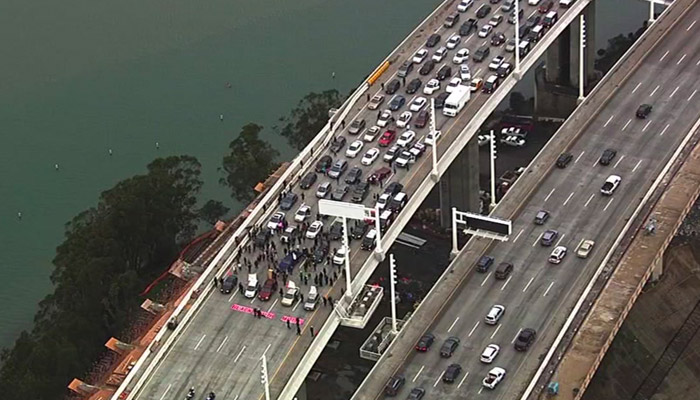
Similarly, government may try to control the flow of unrest by blocking certain paths. Chicago is known, for example, to raise the bridges around downtown to prevent people from escaping while funneling them into more controllable areas.
If you normally rely on public transit, have a backup plan and be ready to walk. Government can easily delay, detour, or shut down public transit. Bicycles make great urban escape vehicles.
Regardless, if you’re in a dense area, you have to assume you might end up on foot. Keep your bug out bag light and “gray.”
Reduce the chances of “crimes of opportunity” at the street level. Don’t leave valuables in the car you park on the street — or better yet, find a way to get your car off the street entirely. Work on improving general home security, such as good door locks and ground-level window locks/bars. Even a strategically-placed bush can make the difference.
The potential list here is endless, so just use your head and think about what you can do to make your home/property less of an easy target.
If you have a street-level business, have window coverings and other anti-vandalism measures ready ahead of time. You don’t want to be buying, cutting, and nailing up random plywood while things turn nasty around you. Even a simple $100 security camera is better than nothing if you need to file an insurance claim.
Learn medical skills. There’s a reason why “street medics” are a thing during unrest — it’s often up to the people to take care of themselves. The Prepared has free lessons, such as how to control bleeding and how to use a tourniquet.
Tactics governments use to control disorder and how things escalate
There is no single playbook everyone uses, even within the same country or region. Some departments make their policies public and clear — such as Washington DC’s Metro Police — while others keep their tactics secret.
Tip: If you can’t easily find your local law enforcement’s policy on google, try giving them a call. Sometimes they’re required to provide the policy but not required to make it easy to find.
This is a decent analysis of how police responded to the 2017 Charlottesville riots:
The simplest thing a government can do to restore order is simply having one uniformed law enforcement officer visible in the area. The most severe form is killing everyone. So what happens in between?
In rough order from first actions to the most extreme:
- Visible presence of multiple uniformed officers
- Requiring permits to assemble or controlling where people can assemble with “Free Speech Zones”, barricades, etc.
- Direct warnings to a crowd, eg. by megaphone or official declaration
- Aggressive postures, eg. lining up riot police shoulder-to-shoulder to project the image of power
- Riot Control Agents, eg. tear gas and pepper spray
- Kinetic weapons, eg. batons and rubber bullets
- Aggressive movements, such as cops suddenly rushing through a street to cause disorientation and fragmentation
- Mass arrests
- Disabling weapons, eg. tasers and flashbangs
- Blocking, censoring, and/or tracking communication, eg. turning off the cell network towers around a protest, tapping phones, or censoring certain keywords like Xi The Pooh.
- People tracking: Facial recognition tech, dyes to physically mark who has been in the area, etc.
- Armored vehicles
- Undercover agents
- More severe crowd control devices, eg. water cannons and sound speakers
- Curfews or restriction of public movement
- Shutting down or censoring press
- Targeted lethal action
- Door-to-door searches and seizures, check points, etc.
- Martial law over a wide area
- Withholding essential services and utilities, ie. “starve the people into compliance”
The groups representing the government usually scale up as things get worse, starting with (in US terms):
- Local street police
- Local “Disorder Control Units”, “Emergency Response Teams”, SWAT, and similar specialized teams
- Regional Sheriffs
- State police
- “All hands on deck” from anyone local
- National Guard under state control
- Federal agencies, such as the DOJ’s Bureau of Prisons
- National Guard under federal control
- Military
- Covert (imagine something like the CIA)
Riot Control Agents: tear gas vs. pepper spray vs. pepper balls
Pepper spray is the street name for oleoresin capsicum, known professionally as OC. The main ingredient is actually derived from hot peppers. Some countries like the UK will refer to OC as PAVA.
Pepper spray is usually a targeted weapon, used to control one or a few people. The most common form is a stream of liquid, but a growing number of governments are also using modified paintballs. Those “pepper balls” can travel further and explode on impact, creating a localized cloud of pepper. Regardless of the form, the pepper “cloud” doesn’t travel as far as tear gas.
We got to test out a civilian pepper ball version at the 2020 SHOT Show (government models might look like this instead):
Tear gas is actually banned by international treaty as an unjust chemical weapon — but that treaty allows countries like the US to still use it for domestic policing.
The key ingredient in tear gas isn’t actually a gas. The part that bothers you is usually a crystallized chemical that is suspended in and delivered through a gas. Those crystals like to attach themselves to moisture, which is why they travel through the air (sometimes over great distances) until they stick to your eyes, sweaty skin, and so on.
There’s a variety of chemicals used to make the crystals in tear gas. It’s rare, but OC (the hot pepper chemical) is sometimes used. CS gas is the most common — and you’ll sometimes hear people refer to tear gas simply by the name CS — although some products use CN or CR gas (more common in the UK).
How to treat pepper spray and tear gas
When the crowd control agents start firing, a natural instinct is to immediately run. Don’t. Not only does running make it more likely you’ll breathe in bad stuff, but the winds can often move the chemicals in unpredictable ways (even backwards).
We have gas in Atlanta. Most of it is blowing back onto police. pic.twitter.com/ZOtbJKGe8S
— Charlie Gile (@CharlieGileNBC) June 1, 2020
If you come in contact:
- Get out of the cloud. Try to find high ground — the chemicals are usually heavier than air and will sink to the ground.
- Do not touch or rub your eyes, mouth, or other “soft” skin tissue!
- Flush with water. This can take up to 15 minutes.
- Blinking fast can cause your eyes to tear up more, which helps with flushing.
- Remove contaminated clothing if you can. Definitely remove contaminated shoes and clothing before going inside your home.
- If you can’t remove clothing and/or had exposed skin, wipe yourself down with a cool damp cloth.
- Take a shower and wash your hair to remove lingering chemicals.
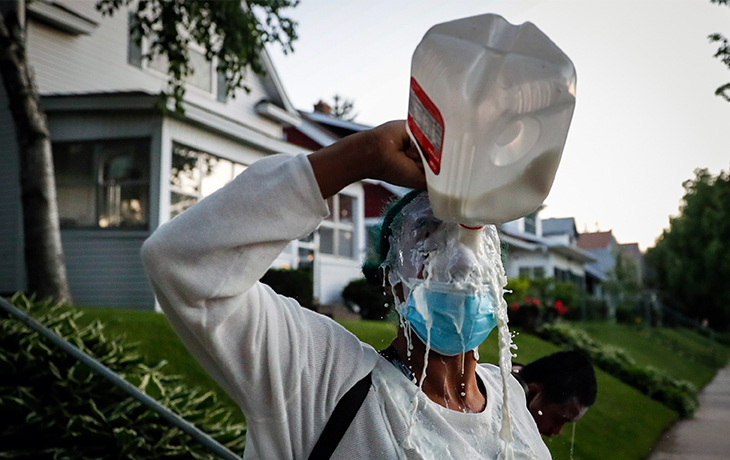
What about milk and other folklore treatments?
- Milk generally doesn’t work better than water, although it can have a soothing/cooling effect on your eyes after pepper spray.
- Some street medics carry a 50-50 mixture of water and liquid antacid (eg. Magnesium Hydroxide or Aluminum Hydroxide), called the LAW method (Liquid Antacid and Water). But at least two clinical studies have found it’s no more effective than water.
- Dish soap, Dr. Bronner’s, and similar folklore treatments fail scientific testing.
Other Crowd Control Weapons
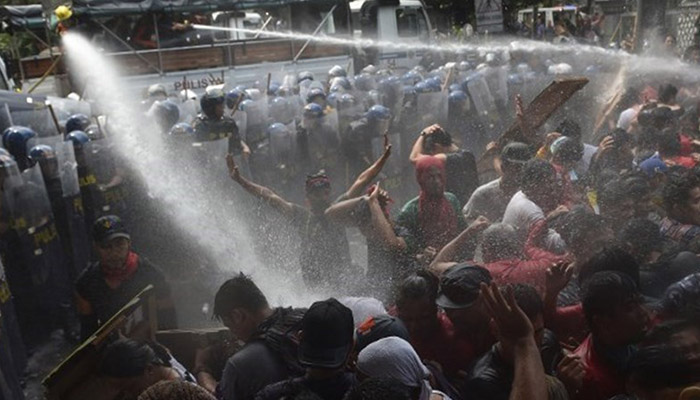
Water cannons might be handheld or mounted to the top of a vehicle. Police might start with a low-enough pressure to just be a nuisance, but if the pressure is dialed up, the water can easily sweep you off your feet or cause real bodily harm. If you’re getting hit, cover your face/head with your arms or other items while seeking cover.
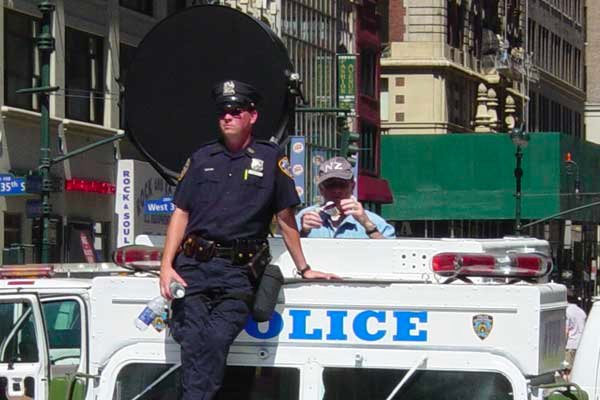
Sound waves can be weaponized. A common model, the Long Range Acoustic Device (LRAD), can be used as a loudspeaker and to create ear pain through extremely loud piercing sounds. Most of these devices work by making the crowd uncomfortable in the ear, although there are sonic weapons that are so powerful they can cause internal tissue and central nervous system damage, even death.
If you’re on the receiving end of a sonic weapon, use your ear protection and put as much stuff or distance between you and the source as possible.
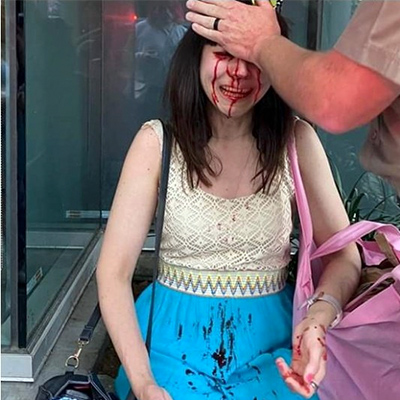
Rubber bullets, “sponge” rounds, and beanbag rounds are not as soft and squishy as they sound — a growing number of protestors are losing eyes and dealing with other serious or fatal injuries from these “less-lethal” projectiles. Projectiles can take multiple forms, such as a standard firearm centerfire round, shotgun shell, 40mm grenade, etc. If these are being shot in your direction, put physical barriers between you and the incoming fire, even if it’s your backpack or arms.
Blunt-force weapons like batons, clubs, and shields are a common way for crowd control units to “beat back” groups of people.
Distance is the best protection
The best advice by far is to put distance between you and the people causing trouble.
For example, one of The Prepared’s staff was on the ground in Egypt around the time of the Arab Spring (ie. the 2011 Egyption Revolution). It was a scary time, with large groups of desperate people shooting rifles while marching through Cairo, a dictator grasping on to power with military force, and essentially no rule of law.
The advice a local professional security team gave? “If you see a group of angry people or a gun, just walk the other way.”
That was it, and in practice, it worked!
Even when things seem bleak, you might be able to turn a corner and find yourself in what feels like a totally different world. That’s called the split screen effect. In many cases, as soon as the rioters get some distance between them, things start to rapidly cool off.
If your home or business is near a riot
Assume you won’t be able to call for help for individual needs, such as calling the police about damage to your home or calling an ambulance for a medical problem. It’s common to hear stories of people calling 911 during unrest and either being completely ignored or told things like “the city is on fire and we have bigger issues, so deal with it yourself.”
A major decision is whether to stay or go. There’s no way to follow a simple checklist to make that decision — it’s a combination of you knowing your surroundings, situational awareness, what’s happening on the ground, how defensible your position is, and so on.
If you do shelter in place, some things to do in the moment:
- Lock all of your doors, windows, gates, etc. and enable any anti-theft/anti-vandalism protection.
- Remove anything unattached from street level: garbage cans, bikes, construction materials, signs, etc.
- Get your vehicles off the street if possible.
- If there’s anything you can do that would let the angry mob know “you’re on their side”, such as putting up a flag or banner outside of your location, that might help avoid trouble.
- Don’t let your position become surrounded. Unless you’re very confident in your ability to defend your position, once things seem like they’re about to spin out of control, it’s better to leave. You don’t want to be barricaded in a house that burns down.
- If you don’t already have the basics of stored water, take the opportunity to fill up any bathtubs, sinks, etc.
- If you don’t already have the basics of energy storage, take the opportunity to charge cell phones, etc.
- Let a loved one outside of the area know what’s going on, if/when you will leave, where you would plan to go, who’s with you, and so on. Remember that when cell networks are clogged, a simple text message is the most likely thing to get through.
- Be ready to leave at a moment’s notice: have your shoes on, go-bag nearby, etc.
If you grab your go-bags and leave, avoid areas likely to be magnets for activity. Specifics may depend on the reason for the unrest — eg. police brutality protests happening outside of police stations, or anti-American protests in another country happening outside “foreigner” hotels and embassies — but the common places to avoid are the physical buildings or neighborhoods for government, finance, and commercial businesses that are attractive during unrest.
It’s tempting to stay and fight, but no property is worth you or your loved one’s lives.
If you decide to stay and defend your castle, be aware of your local laws governing self defense and property defense — while things may be lawless in the moment and there’s an unfair double standard in these situations, you might end up in legal trouble if you defend yourself.
For example, you’d want to understand if your local laws require that you, the victim, first make a real attempt to retreat before using deadly force. On the other hand, you might be covered by Castle Doctrine where you’re allowed to defend yourself in broader situations. There may also be differences in whether you can protect against bodily harm but not against property harm.
You also want to pay attention to if the law allows you to protect other people or their property. You might think you’re doing the right thing by protecting your neighbor’s storefront from looting, but your local laws might not give you that right. An interesting example are the notorious “Roof Koreans” from the 1992 LA Riots.
If you get near unrest but want to avoid it
Avoid getting boxed in anywhere and keep your movement options open at all times. Keep in mind that the movement of crowds can change faster than most people would predict — it’s actually a specific field of study, such as this example of crowd movements at Mecca during Hajj, and researchers talk about the “6% rule” where only six percent of a crowd taking an action (eg. suddenly changing direction) can change the entire crowd.
Do what you can to avoid drawing attention while efficiently but calmly working your way to the edges of the chaos.
Do whatever you can to stay on the edges — once you’re in the mob, it might be hard or impossible to get out again.
Your default choice is to look and act like a “non-combatant.” It’s only when you feel like that isn’t a good enough strategy that you would want to take the risk of trying to blend in with the crowd by wearing a similar uniform, repeating the same chants they are, using your talking points about the issue to make it seem like you’re on their side, etc.
For example, if you do need to say something to an aggressive crowd, you would hope that simply saying this is enough: “Sorry, I support you, but I’m just trying to get my family to safety.” And other humanizing and clear “please don’t hurt me” language.
Don’t cross picket lines or do anything else the crowd will take as offensive.
Don’t get tunnel vision on one side in a multi-sided conflict. You might be worried about the looters directly in front of you, but what about the police in armored vehicles coming down on your position? Or, if you’re focused on the cops, pay attention to if people around you start throwing things (which will escalate the situation).
If shooting breaks out and you can’t easily get away or take cover, lay as low as you can on the ground with your arms and hands spread wide to best indicate you’re not a threat.
If heavy objects are being thrown and you can’t take cover, use anything you have to cover your head and face, with your hands and arms as the shield of last resort. You could also curl into a fetal position with your head and chest protected.
If you’re in a vehicle
Lock your doors.
Turn off the radio/music, or if you do have it on, tune it to the news but keep the volume low enough so you can hear things outside of the car.
Assuming you’re not driving fast, take off your seat belt so you can quickly defend yourself or exit the vehicle.
If you have a weapon, keep it accessible but not easily visible to people nearby.
Some modern vehicles have advanced filtration systems, such as Tesla’s Bioweapons Defense Mode. Turn it on if you have it — it will prevent riot control agents from getting in through the air vents.
Rolling down your windows just a little makes the glass harder to break. One side not being tightly held by the frame means the glass will wobble and absorb more of the impact.
If you’re in a situation where people on foot are directly around your vehicle, but they aren’t focused on you or your car, then either sit still and let them pass by you (if they’re moving), or go as slow as possible to work your way to the nearest edge (if they’re not moving).
If people surround your vehicle in an aggressive way, it’s better to maintain a controlled speed that gently pushes/forces people out of your way. Accelerating to ramming speed is not as effective — you’re more likely to inflame things, cause damage to your car, get stuck, hurt an innocent, etc.
If your car starts to smoke, is lit on fire, carjackers are attacking, and so on, don’t stick around too long. A car is not worth your life, and since you’re a sane prepper, you’re ready to continue on foot with your go-bag.
What to do if you’re approached by police
If you’re anywhere near trouble, you have to assume that the police will think you’re a threat (at least at first). Assuming you aren’t a threat, try to make it obvious:
- Keep your hands empty, open, and easily visible
- If you’re in a car, put your empty hands palms-up on the steering wheel or similar so the approaching officers feel safer
- Don’t hide your face
- Don’t reach for your pockets
- Quickly follow all instructions
- Stay calm and communicate clearly
Do not resist arrest if you still have any faith in the local justice system! Since all governments’ primary goal is to get things back under control, they would rather err on the side of rounding up people then sort it all out later.
Even if you’re totally innocent, once they’ve decided to capture you, they won’t give up easily. Stay calm, keep quiet, and figure it out later — a day in jail while things get sorted is far better than an injury, follow-up criminal charge (ie. they have your face on camera and find you later, now with an extra charge), or worse.
Video is your friend. Just be mindful so that holding a phone in your hand won’t be mistaken as a weapon. Let your camera record at all times, assuming you have ample memory. If you’re being arrested, yell to people around you to video it. Yell your name.
If you’re particularly worried about an oppressive regime with a history of “disappearing dissenters” and find yourself being taken, you may want to yell out, on camera, “My name is ____ and I WILL NEVER KILL MYSELF!” It probably won’t keep the regime from hurting you, but at least there’s a record of it and you’ve taken away the “they committed suicide” excuse.
How to help other people
If things are calm and you just want to help people protesting, try providing water, sunscreen, hand sanitizer, and so on. And there’s always value in having more video cameras rolling from safe/neutral positions.
If you’re helping someone hit with riot control agents:
- Verbally identify yourself — they might not be able to see.
- Help keep them calm, remind them the pain is temporary, and walk them through the treatment steps.
- Be careful with your hands when touching them, such as helping to flush out their eyes with a water bottle. If you have uncontaminated medical gloves, put them on.
Be careful with uploading pictures and videos to the public. It’s normally a good thing to have cameras around to document things like police misconduct. But keep in mind that, if you post any media online, it’s likely to be used by law enforcement for facial recognition and could cause problems for people you didn’t want to hurt.
The best thing to do is have files on your phone automatically uploaded to a private cloud, such as Dropbox or Google Drive. That way the video isn’t only on your device — in case it’s lost or police delete it — but isn’t open to the public.
